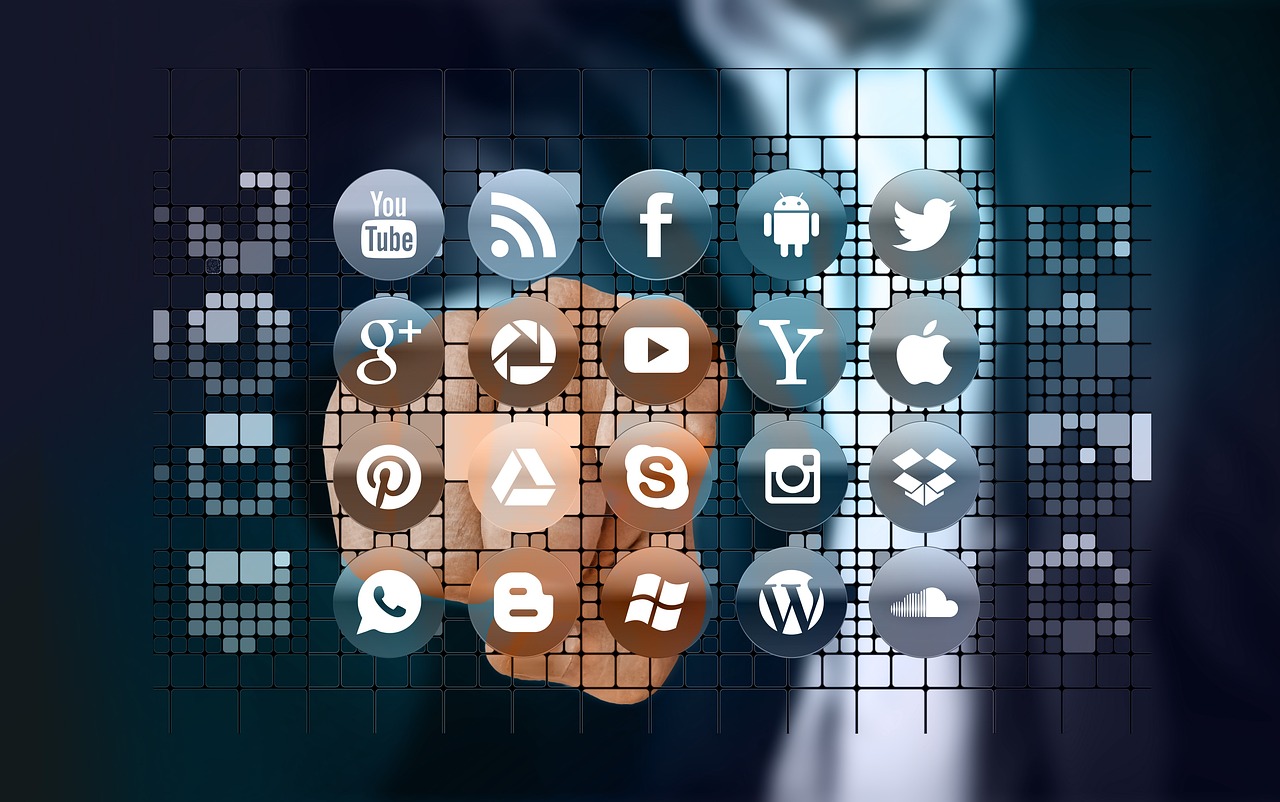The Link Between Social Media and Cybercrime
In today's digital age, social media platforms have become an integral part of our daily lives. From sharing personal moments to connecting with friends and family, these platforms offer a plethora of opportunities for communication and engagement. However, this increased connectivity also opens the door to a darker side: cybercrime. The intricate relationship between social media and cybercrime is both alarming and fascinating, as it showcases how the very tools designed to bring us closer can also be exploited for malicious purposes. As we dive into this topic, we will uncover the various ways in which social media can facilitate illicit activities while also examining the measures being taken to combat these threats.
The prevalence of cybercrime on social media is on the rise, and the statistics are staggering. According to recent studies, nearly 60% of adults have experienced some form of cybercrime, with social media being a primary avenue for these attacks. This includes everything from identity theft to phishing scams, and the numbers continue to grow year after year. With billions of users worldwide, social media platforms present a goldmine for cybercriminals looking to exploit unsuspecting individuals. The anonymity and accessibility of these platforms make it easier than ever for criminals to target their victims, leading to a significant increase in reported incidents.
Understanding the various forms of cybercrime that can occur on social media is crucial for users to protect themselves. Here are some of the most common types:
- Identity Theft: Criminals often use social media to gather personal information, which they can then use to impersonate victims.
- Phishing Scams: Fake accounts and deceptive links are common tactics used to trick users into providing sensitive information.
- Cyberbullying: The anonymity of social media can lead to harmful behaviors, impacting the mental health of victims.
Identity theft is one of the most alarming types of cybercrime facilitated by social media. Cybercriminals can easily exploit the personal information shared by users, such as birthdays, addresses, and even phone numbers. By piecing together this information, they can create a detailed profile of their victims, which can lead to unauthorized access to bank accounts, credit cards, and other sensitive data. The consequences for victims can be devastating, often resulting in financial loss and a lengthy process to restore their identities.
Phishing scams are another prevalent issue on social media. Cybercriminals create fake accounts that mimic legitimate businesses or trusted friends, luring users into clicking on malicious links. These deceptive tactics can lead to malware infections or the theft of personal information. It's essential for users to remain vigilant and to verify the authenticity of accounts before engaging with them. Always ask yourself: "Is this too good to be true?" If it feels suspicious, it probably is.
Cyberbullying is a serious issue that has gained attention in recent years. The anonymity provided by social media can embolden individuals to engage in harmful behavior without facing immediate consequences. Victims of cyberbullying often suffer from severe mental health issues, including anxiety, depression, and low self-esteem. It is crucial for social media platforms to take responsibility and implement measures to combat this behavior, fostering a safer online environment for all users.
To combat the rising tide of cybercrime, users must take proactive steps to protect themselves. Here are some practical tips:
- Regularly update privacy settings to control who can see your information.
- Be cautious about sharing personal details publicly.
- Recognize suspicious activity, such as unexpected messages or friend requests.
Social media companies play a vital role in addressing the threat of cybercrime. They are continuously developing and implementing policies, security measures, and community guidelines aimed at protecting users from potential threats. These efforts are essential in creating a safer online environment where users can enjoy the benefits of social media without falling victim to cybercriminals.
Many social media platforms have introduced various security features to safeguard user data. For instance, two-factor authentication adds an extra layer of security, making it more difficult for unauthorized users to access accounts. Reporting tools allow users to flag suspicious accounts or content, helping to maintain a safer community. These features are crucial in the ongoing battle against cybercrime.
Collaboration between social media companies and law enforcement agencies is essential in tackling cybercrime effectively. By sharing information and resources, they can identify and apprehend cybercriminals more efficiently. Successful initiatives have already been launched, but challenges remain, particularly in navigating the complexities of jurisdiction and privacy laws.
Q1: What is the most common type of cybercrime on social media?
A: Identity theft is one of the most prevalent forms of cybercrime on social media, as criminals exploit personal information shared by users.
Q2: How can I protect myself from phishing scams?
A: Always verify the authenticity of accounts before clicking on links or providing personal information. If something seems off, trust your instincts.
Q3: What should I do if I experience cyberbullying?
A: Report the behavior to the social media platform and seek support from friends, family, or mental health professionals.

The Rise of Cybercrime on Social Media
As we navigate the ever-evolving digital landscape, the rise of cybercrime on social media has become a pressing concern for users and authorities alike. Social media platforms, once celebrated for their ability to connect people, have inadvertently opened the floodgates for a myriad of illicit activities. With billions of users worldwide, these platforms have become prime hunting grounds for cybercriminals looking to exploit unsuspecting individuals. In fact, recent statistics reveal a staggering increase in cybercrime incidents linked to social media, with reports indicating that over 60% of users have encountered some form of cyber threat while engaging on these platforms.
The alarming growth of cybercrime can be attributed to several factors. First and foremost, the sheer volume of personal information shared online makes social media a goldmine for cybercriminals. Users often post details about their lives, including locations, family members, and even financial information, without realizing the risks involved. Moreover, the anonymity provided by the internet allows malicious actors to operate without fear of repercussions, emboldening them to launch attacks with relative ease.
Statistics also show that cybercrime on social media is not just a minor nuisance; it has escalated into a significant threat. According to a recent report by the Cybersecurity and Infrastructure Security Agency (CISA), approximately 70% of all cybercrime incidents now involve social media platforms. This encompasses a wide range of activities, from data breaches to sophisticated phishing schemes that target users through direct messages and fake accounts. The implications are severe, as victims often face not only financial loss but also emotional distress and a loss of trust in the platforms they once relied upon.
To further illustrate the growing risks, consider the following table that highlights the most common types of cybercrime reported on social media:
| Type of Cybercrime | Percentage of Incidents |
|---|---|
| Identity Theft | 30% |
| Phishing Scams | 25% |
| Cyberbullying | 20% |
| Malware Distribution | 15% |
| Account Hijacking | 10% |
As the statistics indicate, identity theft and phishing scams are at the forefront of cybercrime on social media. These crimes not only threaten individual users but also undermine the integrity of the platforms themselves. Users are left wondering how to protect themselves in such a precarious environment. The reality is that as long as social media continues to thrive, cybercriminals will find new and inventive ways to exploit weaknesses within these systems.
In conclusion, the rise of cybercrime on social media is a complex issue that demands attention. Users must remain vigilant and informed about the potential dangers lurking behind every post and interaction. As we delve deeper into the types of cybercrime prevalent on these platforms, understanding the landscape is crucial for safeguarding personal information and maintaining a safe online presence.

Social media has transformed the way we connect, share, and communicate. However, it has also become a breeding ground for various forms of cybercrime. With millions of users globally, platforms like Facebook, Twitter, Instagram, and others have inadvertently opened the door for malicious activities that can have devastating effects on individuals and communities alike. Understanding the different types of cybercrime prevalent on these platforms is crucial for users to protect themselves and navigate the digital landscape safely.
One of the most alarming types of cybercrime is identity theft. Cybercriminals often exploit social media to gather personal information, such as names, addresses, and birthdates, which they can use to impersonate individuals. This can lead to significant financial loss and emotional distress for victims. For instance, a scammer might create a fake profile using someone else's details, tricking friends and family into sharing sensitive information or money. In fact, according to recent studies, nearly 30% of identity theft cases begin with information gleaned from social media platforms.
Another prevalent form of cybercrime on social media is phishing scams. These scams typically involve cybercriminals creating fake accounts or deceptive links that lure users into providing personal information, such as passwords or credit card numbers. Users might receive messages from what appears to be a trusted friend or a legitimate company, prompting them to click on a link that leads to a fraudulent website. Here’s a quick rundown of how phishing scams manifest on social media:
- Fake Accounts: Scammers often set up profiles that mimic real individuals or organizations to gain trust.
- Deceptive Links: Links that promise rewards or exclusive content can lead to malicious sites designed to steal information.
- Urgency Tactics: Messages that create a sense of urgency can pressure users into acting quickly without thinking.
Cyberbullying is yet another serious issue that has gained traction with the rise of social media. It involves the use of digital platforms to harass, threaten, or embarrass individuals, often leading to severe emotional and psychological consequences. The anonymity that social media provides can embolden bullies, making it easier for them to target victims without facing immediate repercussions. The impact of cyberbullying can be profound, affecting mental health, self-esteem, and overall well-being. Victims may experience anxiety, depression, and even suicidal thoughts as a result of persistent online harassment.
In addition to these forms of cybercrime, social media can also be a platform for scams and fraud. From fake giveaways to pyramid schemes, users are often lured into schemes that promise quick financial gains but ultimately lead to loss. The combination of social interaction and the desire for quick rewards can make users vulnerable to these deceptive practices.
Recognizing these types of cybercrime is the first step in protecting oneself online. Users must stay vigilant and informed about the risks associated with social media. By understanding how these crimes manifest, individuals can take proactive measures to safeguard their personal information and well-being.

Identity theft is like a digital masquerade ball where cybercriminals wear the masks of unsuspecting users to steal their identities. Social media platforms, which are designed to foster connection and community, unfortunately, provide a fertile ground for such nefarious activities. With millions of users sharing personal information daily, the risk of identity theft has skyrocketed. In fact, studies show that approximately 40% of identity theft cases begin with information obtained from social media profiles. This alarming statistic highlights the importance of understanding how thieves exploit these platforms.
So, how exactly do these cybercriminals operate? They often use a variety of tactics to gather personal information. For instance, they might create fake profiles that mimic legitimate accounts to gain the trust of unsuspecting users. Once they establish this trust, they can trick individuals into divulging sensitive information such as email addresses, phone numbers, and even social security numbers. Additionally, some criminals employ advanced techniques like social engineering, where they manipulate users into revealing personal details through deceptive messages or posts.
The consequences of identity theft can be devastating. Victims may experience financial loss, damage to their credit scores, and a long, arduous process to reclaim their identities. It's not just about the immediate impact; the emotional toll can be significant as well. Imagine waking up one day to find that your bank account has been emptied or that someone has taken out loans in your name. It’s a nightmare that can leave victims feeling vulnerable and violated.
To illustrate the seriousness of identity theft on social media, consider the following table that outlines common tactics used by cybercriminals along with their potential impacts:
| Tactic | Description | Potential Impact |
|---|---|---|
| Fake Profiles | Criminals create accounts that mimic real users. | Trust is gained, leading to information sharing. |
| Phishing Messages | Deceptive messages prompting users to click on links. | Malware installation or data theft. |
| Social Engineering | Manipulating users into revealing personal information. | Identity theft and financial loss. |
The best defense against identity theft on social media is awareness and vigilance. Users should regularly review their privacy settings to ensure that personal information is not publicly accessible. Additionally, it's crucial to be skeptical of friend requests from unknown individuals and to verify the authenticity of any messages received, especially those asking for personal details. Remember, if something seems too good to be true, it probably is!
As social media continues to evolve, so too do the methods used by cybercriminals. Staying informed and proactive is essential in the fight against identity theft. By taking the necessary precautions and being aware of the tactics employed by thieves, users can enjoy the benefits of social media while minimizing their risks.

In today’s digital landscape, phishing scams have become a prevalent threat, especially on social media platforms. These scams are designed to deceive users into providing sensitive information such as passwords, credit card numbers, and personal identification. Imagine scrolling through your feed, only to find a message from a friend that looks legitimate but is actually a cleverly disguised trap. This is the reality many users face, as cybercriminals exploit the trust inherent in social networks.
Phishing scams can take various forms, but they often share common tactics that make them effective. One of the most alarming methods is the creation of fake accounts that impersonate legitimate users or organizations. For instance, a scammer might create a profile that mimics your bank, complete with the bank's logo and a convincing backstory. They may then send you a friend request or direct message, urging you to click on a link that leads to a fraudulent website designed to capture your login credentials. This is not just a simple trick; it’s a sophisticated form of deception that can have devastating consequences for victims.
Another common tactic involves deceptive links. These links often appear harmless, leading users to believe they are clicking on something innocuous—like a viral video or an exciting news article. However, once clicked, these links can redirect users to phishing sites or even download malware onto their devices. According to a recent report, over 60% of users have encountered phishing attempts on social media, highlighting the urgent need for vigilance.
Understanding how to identify these scams is crucial. Here are some signs to look out for:
- Unusual Requests: Be wary of messages asking for personal information, especially if they come from friends who might have had their accounts hacked.
- Poor Grammar and Spelling: Many phishing messages are riddled with errors, which can be a red flag.
- Urgency: Scammers often create a sense of urgency, prompting users to act quickly without thinking.
To combat phishing scams, social media platforms have implemented various security measures. Users are encouraged to enable two-factor authentication, which adds an extra layer of protection. Additionally, reporting suspicious accounts and messages can help keep the community safe. Remember, if something seems too good to be true, it probably is. Always verify the source before clicking on links or providing personal information.
As we navigate the complexities of social media, staying informed about phishing scams is essential. By recognizing the signs and understanding the tactics employed by cybercriminals, users can better protect themselves from falling victim to these malicious schemes. In an age where our digital identities are more valuable than ever, safeguarding our information should be a top priority.
1. What should I do if I receive a suspicious message on social media?
If you receive a message that seems suspicious, do not click on any links or provide personal information. Report the message to the platform and inform the sender if you believe their account has been compromised.
2. How can I tell if a social media account is fake?
Look for signs such as a lack of followers, generic profile pictures, and posts that seem out of character for the person or organization they claim to represent.
3. Is it safe to click on links shared by friends?
Not always. If a link seems unusual or your friend has not personally shared it with you, it’s best to verify with them before clicking.
4. What are some additional steps I can take to protect myself from phishing scams?
Regularly update your passwords, use unique passwords for different accounts, and stay informed about the latest phishing tactics. Consider using a password manager to help keep track of your credentials securely.

In today's digital age, cyberbullying has emerged as a significant concern, especially on social media platforms where anonymity can shield the perpetrators. Unlike traditional bullying, which typically occurs in person, cyberbullying can happen anytime and anywhere, making it even more pervasive. Victims often find themselves trapped in a cycle of harassment that can be relentless and overwhelming. The impact of this behavior is profound, affecting not just the immediate emotional state of the victim but also their long-term mental health.
Statistics reveal the alarming scope of the problem. According to recent studies, approximately 37% of young people aged 12-17 have been bullied online. This isn't just a number; it represents real lives affected by the cruel words and actions of others. The anonymity of social media allows bullies to act without fear of immediate consequences, leading to a culture of impunity. Victims can experience a range of emotional responses, from anxiety and depression to feelings of isolation and hopelessness.
One of the most troubling aspects of cyberbullying is its potential to escalate. A single negative comment can lead to a barrage of harassment, creating a toxic environment that can feel inescapable. Victims may withdraw from social interactions, fearing further attacks, which can lead to a downward spiral of loneliness and despair. The psychological effects can be long-lasting, with some individuals carrying the scars of their experiences well into adulthood.
Social media platforms have a crucial role to play in combating cyberbullying. They must not only implement effective reporting mechanisms but also foster a culture of respect and kindness among users. This includes educating users about the impact of their words and encouraging positive interactions. Some platforms have introduced features that allow users to block or mute bullies, but these measures alone are not enough. Comprehensive strategies are needed to address the root causes of cyberbullying and support victims in their recovery.
As we navigate this complex issue, it’s essential to remember that cyberbullying is not just a personal issue; it’s a societal one. Everyone has a role to play in creating a safer online environment. Parents, educators, and peers must work together to raise awareness and promote empathy. By fostering open conversations about the effects of bullying, we can begin to dismantle the stigma surrounding it and empower victims to speak out.
In summary, the impact of cyberbullying is far-reaching, affecting not only the individuals directly involved but also the broader community. It’s a reminder of the power of words and the responsibility we all share in ensuring that social media remains a space for connection rather than conflict.

In a world where social media is an integral part of our daily lives, protecting ourselves from cybercrime has never been more crucial. The digital landscape is rife with potential threats, but there are effective strategies that users can implement to safeguard their personal information and enhance their online security. One of the first steps is to regularly update your privacy settings. Most social media platforms offer customizable privacy options that allow you to control who can see your posts, send you friend requests, or even look you up. Take a moment to review these settings and adjust them according to your comfort level—after all, you wouldn’t leave your front door wide open, would you?
Another vital strategy is to use strong, unique passwords for each of your social media accounts. A password should be a complex mix of letters, numbers, and symbols, making it difficult for cybercriminals to crack. Consider using a password manager to keep track of your passwords securely. Additionally, enabling two-factor authentication (2FA) can add an extra layer of security. This means that even if someone manages to get hold of your password, they would still need a second form of verification, such as a code sent to your phone, to access your account.
Awareness is key when it comes to recognizing suspicious activity. Be cautious of unsolicited messages or friend requests, especially from people you don’t know. Cybercriminals often create fake profiles to lure unsuspecting users into sharing personal information. If you receive a message that seems off or requests sensitive information, it’s best to ignore it or report it. You can also educate yourself on common scams and tactics used by cybercriminals. Knowledge is power, and understanding the methods they employ can help you recognize potential threats before they escalate.
Moreover, regularly monitoring your online presence can help you stay ahead of any potential threats. Conduct a search for your name to see what information is publicly available about you. If you find anything that concerns you, consider taking steps to remove it. It’s also wise to keep an eye on your accounts for any unauthorized activity. If you notice any strange logins or changes to your profile, act quickly by changing your password and reporting the activity to the platform.
Lastly, remember that sharing information online can have lasting consequences. Think twice before posting personal details like your address, phone number, or vacation plans. Cybercriminals can use this information to target you more effectively. Instead, focus on sharing content that reflects your interests and personality without compromising your safety. By following these strategies, you can enjoy the benefits of social media while minimizing the risks associated with cybercrime.
- What is the best way to create a strong password? A strong password should be at least 12 characters long and include a mix of uppercase letters, lowercase letters, numbers, and symbols. Avoid using easily guessable information like birthdays or names.
- How can I tell if a message is a phishing attempt? Look for signs such as poor spelling and grammar, urgent language, or requests for personal information. If it seems suspicious, don’t click on any links or provide any information.
- What should I do if I believe I’m a victim of cybercrime? Change your passwords immediately, report the activity to the social media platform, and consider contacting local law enforcement if necessary.

In the digital age, social media companies find themselves at the forefront of a complex battle against cybercrime. As platforms that connect billions of users worldwide, they hold a unique position of responsibility. With great power comes great responsibility, and these companies must navigate the treacherous waters of user safety while fostering a vibrant online community. So, how exactly are they stepping up to the plate?
First and foremost, social media companies have begun implementing a range of security measures designed to protect users from cyber threats. These measures include advanced algorithms that detect suspicious activities, robust reporting tools for users to flag inappropriate content, and comprehensive privacy settings that empower users to control their information. For example, platforms like Facebook and Twitter have introduced features that allow users to review and adjust their privacy settings with just a few clicks, ensuring that personal data is not easily accessible to malicious actors.
Moreover, many social media companies have adopted community guidelines that outline acceptable behavior on their platforms. These guidelines serve as a framework for users, helping to create a safer online environment. Violations of these guidelines can lead to account suspensions or bans, which act as a deterrent for potential cybercriminals. The challenge, however, lies in enforcing these guidelines consistently and fairly, as the sheer volume of content generated daily can overwhelm moderation efforts.
Another crucial aspect of the role of social media companies is their collaboration with law enforcement agencies. This partnership is essential for tackling cybercrime effectively. By sharing information and resources, social media platforms can assist in investigations and help bring perpetrators to justice. For instance, companies like Instagram and Snapchat have worked with law enforcement to address issues like child exploitation and online harassment, providing valuable data that aids in prosecuting offenders. However, this collaboration is not without its challenges, as privacy concerns and the need for transparency can complicate these relationships.
To further illustrate the impact of these initiatives, let's take a look at a table summarizing some of the key security features implemented by major social media companies:
| Social Media Platform | Security Features |
|---|---|
| Two-factor authentication, privacy checkup tool, user reporting options | |
| Login verification, account activity log, reporting abusive behavior | |
| Two-factor authentication, comment filtering, reporting tools for harassment | |
| Snapchat | Ghost mode for location sharing, reporting features, privacy settings |
As we can see, social media companies are not just passive platforms; they are actively engaging in the fight against cybercrime. However, the responsibility does not solely rest on their shoulders. Users must also play a vital role in maintaining their safety online. By staying informed about potential threats and utilizing the security features provided, individuals can significantly reduce their risk of becoming victims of cybercrime.
In conclusion, the role of social media companies in combating cybercrime is multifaceted and constantly evolving. Through the implementation of security measures, adherence to community guidelines, and collaboration with law enforcement, these platforms are making strides in protecting their users. Yet, the journey is far from over, and as cybercriminals continue to innovate, so too must the strategies employed by social media companies to ensure a safe online environment for everyone.
- What are social media companies doing to combat cybercrime? They are implementing security measures, community guidelines, and collaborating with law enforcement to enhance user safety.
- How can users protect themselves on social media? Users can utilize privacy settings, report suspicious activity, and stay informed about potential threats to safeguard their accounts.
- Are social media platforms effective in preventing cybercrime? While they have made significant progress, the effectiveness varies, and ongoing efforts are necessary to address the evolving nature of cyber threats.

In today's digital age, where social media is intricately woven into the fabric of our daily lives, the importance of robust security measures cannot be overstated. Social media platforms are aware of the myriad of threats that users face, and they have begun to implement a variety of security features designed to protect user data and enhance overall safety. These features are not just technical upgrades; they represent a commitment to safeguarding the community from the lurking dangers of cybercrime.
One of the most significant advancements in security is the implementation of two-factor authentication (2FA). This feature adds an additional layer of protection by requiring users to provide two forms of identification before accessing their accounts. Typically, this means entering a password and then confirming access via a code sent to their mobile device. By requiring that second step, platforms significantly reduce the risk of unauthorized access, making it much harder for cybercriminals to hijack accounts.
Another crucial feature is the availability of reporting tools that allow users to flag suspicious behavior or content. These tools empower the community to take an active role in maintaining safety. For example, if a user encounters a fake account or a phishing attempt, they can quickly report it to the platform. This not only helps to protect the individual but also alerts the platform to potential threats that may affect other users. Social media companies often respond promptly to these reports, taking necessary actions to investigate and eliminate the threat.
Additionally, platforms are increasingly utilizing machine learning algorithms to detect and prevent fraudulent activities. These algorithms analyze user behavior to identify patterns that may indicate malicious intent. For instance, if an account suddenly starts sending a high volume of messages to strangers, the algorithm can flag this behavior for further review. This proactive approach helps to catch potential threats before they escalate into serious issues.
Moreover, many social media platforms now offer users the ability to customize their privacy settings more extensively than ever before. Users can control who sees their posts, who can send them messages, and who can tag them in photos. By taking advantage of these settings, users can create a more secure environment for themselves and reduce the chances of falling victim to cybercrime.
In summary, the security features implemented by social media platforms are vital in the ongoing battle against cybercrime. As the digital landscape continues to evolve, so too must the strategies to protect users. By utilizing tools like two-factor authentication, reporting mechanisms, machine learning, and customizable privacy settings, users can significantly enhance their safety online. However, it is crucial for individuals to remain vigilant and proactive in their online activities, as no system is entirely foolproof.
- What is two-factor authentication? Two-factor authentication (2FA) is a security process in which the user provides two different authentication factors to verify themselves, adding an extra layer of security beyond just a password.
- How can I report suspicious activity on social media? Most social media platforms have a reporting feature that allows you to flag suspicious accounts or content. Look for a 'Report' option on the profile or post in question.
- Are machine learning algorithms effective in preventing cybercrime? Yes, machine learning algorithms can analyze user behavior and detect patterns that indicate potential fraudulent activities, helping to prevent cybercrime proactively.

In the ever-evolving battle against cybercrime, social media companies are increasingly recognizing the importance of collaborating with law enforcement agencies. This partnership is crucial for developing effective strategies to combat the rising tide of online illicit activities. Just as a well-coordinated team can win a sports game, the collaboration between tech giants and law enforcement can significantly enhance the fight against cybercriminals. By sharing data and insights, these entities can create a more robust defense mechanism to protect users.
One of the primary benefits of this collaboration is the ability to quickly respond to cyber threats. When a user reports suspicious activity, social media platforms can immediately alert law enforcement, allowing them to take swift action. This is particularly vital in cases of identity theft or online harassment, where time is of the essence. For instance, if a user notices unauthorized access to their account, the platform can flag the incident and work with authorities to trace the origin of the breach.
Moreover, social media companies often provide training and resources to law enforcement agencies to help them understand the unique challenges of cybercrime. This includes sharing knowledge about the latest trends in cyber threats, such as the use of encrypted messaging apps by criminals, which can obscure their activities. By equipping law enforcement with the necessary tools and knowledge, social media platforms are playing a pivotal role in enhancing the overall security landscape.
However, the collaboration is not without its challenges. Issues such as user privacy and data protection often come into play, raising questions about how much information can be shared without compromising individual rights. To navigate these complexities, social media companies must establish clear guidelines that balance the need for security with respect for user privacy. For example, they might implement strict protocols that dictate when and how user data can be shared with law enforcement, ensuring that any cooperation is both ethical and legal.
As the landscape of cybercrime continues to shift, ongoing dialogue between social media companies and law enforcement is essential. This partnership can lead to the development of innovative technologies and practices that make it harder for criminals to operate online. By fostering a culture of collaboration, both parties can work together to create safer online environments for users. The stakes are high, and the consequences of inaction can be severe, making this collaboration not just beneficial, but necessary.
- How do social media companies report cybercrime to law enforcement?
Social media companies have established protocols to report incidents of cybercrime. When suspicious activity is detected, they can alert law enforcement agencies through dedicated channels, often involving real-time communication to expedite investigations. - What types of information can social media companies share with law enforcement?
Typically, social media companies can share user account information, IP addresses, and activity logs, provided that it aligns with privacy laws and regulations. They must ensure that any data shared is necessary for the investigation at hand. - Are there any legal requirements for social media companies to collaborate with law enforcement?
While there are no blanket requirements, social media companies may be legally obligated to comply with specific requests from law enforcement, especially in cases involving serious crimes or threats to public safety.
Frequently Asked Questions
- What is the connection between social media and cybercrime?
Social media platforms have become a breeding ground for cybercrime due to their vast user base and the amount of personal information shared. Cybercriminals exploit these platforms to commit various crimes, such as identity theft, phishing, and cyberbullying.
- What types of cybercrime are most common on social media?
Some of the most common types of cybercrime on social media include identity theft, where criminals steal personal information; phishing scams, which trick users into giving away sensitive data; and cyberbullying, which involves harassment and intimidation online.
- How can I protect myself from identity theft on social media?
To protect yourself from identity theft, be cautious about the information you share. Adjust your privacy settings to limit who can see your posts, avoid accepting friend requests from unknown individuals, and regularly monitor your accounts for suspicious activity.
- What are phishing scams, and how can I recognize them?
Phishing scams are deceptive attempts to obtain sensitive information by pretending to be a trustworthy entity. You can recognize them by looking for signs like poor grammar, suspicious links, or messages from unknown accounts asking for personal details.
- What should I do if I experience cyberbullying on social media?
If you're a victim of cyberbullying, it's important to document the incidents, block the bully, and report their behavior to the platform. Many social media sites have policies in place to address harassment and can take action against offenders.
- What security measures do social media companies implement to combat cybercrime?
Social media companies employ various security measures, including two-factor authentication, which adds an extra layer of protection, and reporting tools that allow users to flag suspicious activity. These features help safeguard user data and prevent cybercrime.
- How do social media companies collaborate with law enforcement?
Social media companies often work with law enforcement agencies to address cybercrime by sharing information and resources. This collaboration helps in tracking down criminals and improving safety measures for users on these platforms.



















